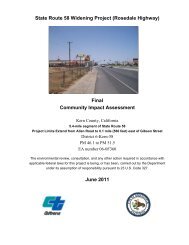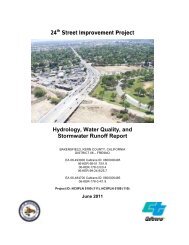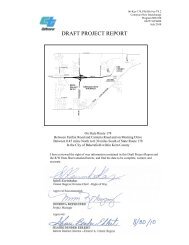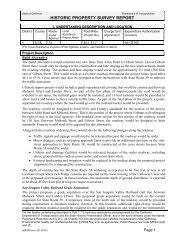State Route 58 Widening Project - Bakersfield Freeways
State Route 58 Widening Project - Bakersfield Freeways
State Route 58 Widening Project - Bakersfield Freeways
Create successful ePaper yourself
Turn your PDF publications into a flip-book with our unique Google optimized e-Paper software.
Chapter 1 Introduction<br />
In 2008, USFWS and CDFG concurred on methods proposed by Stephanie Coppeto<br />
and Leo Edson to develop the kit fox conceptual strategy: diurnal surveys for kit fox<br />
dens and signs, collaboration with Dr. Brian Cypher, and a project specific and<br />
cumulative approach to evaluating potential impacts on kit fox and efforts to avoid,<br />
minimize, and compensate for potential effects. USFWS, CDFG, Caltrans, Stephanie<br />
Coppeto and Leo Edson, and the City agreed to meet throughout the development of<br />
the conceptual strategy to ensure that it complies with the FESA and California<br />
Endangered Species Act (CESA). In July, 2008, CDFG, Caltrans, Stephanie Coppeto<br />
and Leo Edson, the City, Steven Pruett, and Dr. Brian Cypher toured various TRIP<br />
projects in <strong>Bakersfield</strong>. In August, 2008, Stephanie Coppeto and Leo Edson presented<br />
preliminary results of kit fox surveys. USFWS identified habitat connectivity and the<br />
maintenance of corridors connecting kit fox populations as a major issue facing kit fox<br />
in <strong>Bakersfield</strong>. Potential compensatory mitigation options were discussed, including<br />
culverts, refugia, and artificial kit fox dens.<br />
In 2009, USFWS and CDFG approved the San Joaquin Kit Fox Life History, Effects<br />
Analysis, and Conceptual Mitigation Strategy (City of <strong>Bakersfield</strong> and Caltrans 2009)<br />
that describes program-level impacts and conceptual program-level mitigation.<br />
USFWS and CDFG concurred that Caltrans should begin to develop a mitigation<br />
implementation plan of the conceptual approach.<br />
In 2010, USFWS and CDFG approved the Implementation Plan (City of <strong>Bakersfield</strong><br />
and Caltrans 2010). CDFG recommended that Caltrans seek a 2080.1 Consistency<br />
Determination for projects requiring a state Incidental Take Permit. USFWS and<br />
CDFG approved the standard Avoidance and Minimization Measures that would be<br />
described for the San Joaquin kit fox in BAs. USFWS and CDFG agreed that the letter<br />
from the MBHCP Trust Group to the City (dated August 3, 2010) approving eligible<br />
TRIP projects to participate in the fee payment program was valid for projects that are<br />
ready to build prior to MBHCP expiration in 2014 but asked that the City clarify that<br />
fees can be paid at higher than 1:1 ratios as required by USFWS. USFWS and CDFG<br />
approved the concept of the Sump Habitat Program to compensate for program-level<br />
effects.<br />
In 2011, based on agency consultation and the release of the Draft Biological Opinion<br />
for the Morning Drive/<strong>State</strong> <strong>Route</strong> 178 Interchange <strong>Project</strong>, a 3:1 mitigation ratio is<br />
identified for all permanent impacts and a 1.1:1 ratio is identified for all temporary<br />
impacts. Caltrans is no longer seeking an Incidental Take Permit or a Consistency<br />
Determination under CESA as it is now assumed that take of San Joaquin kit fox, as<br />
<strong>State</strong> <strong>Route</strong> <strong>58</strong> <strong>Widening</strong> <strong>Project</strong> Biological Assessment 9








